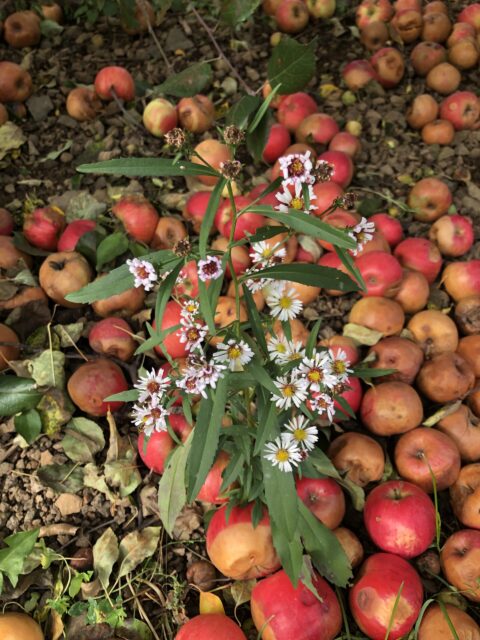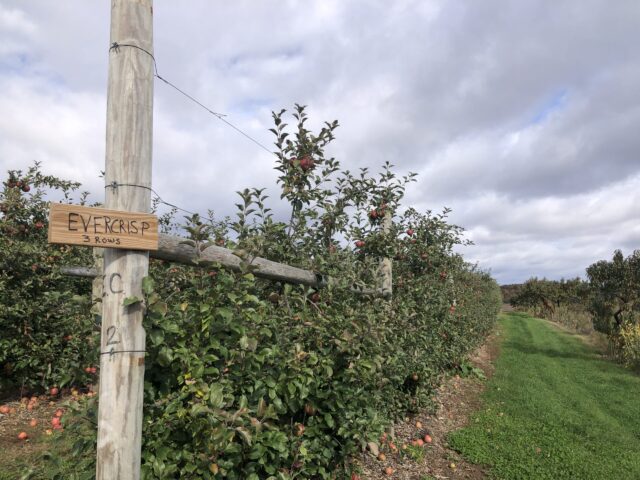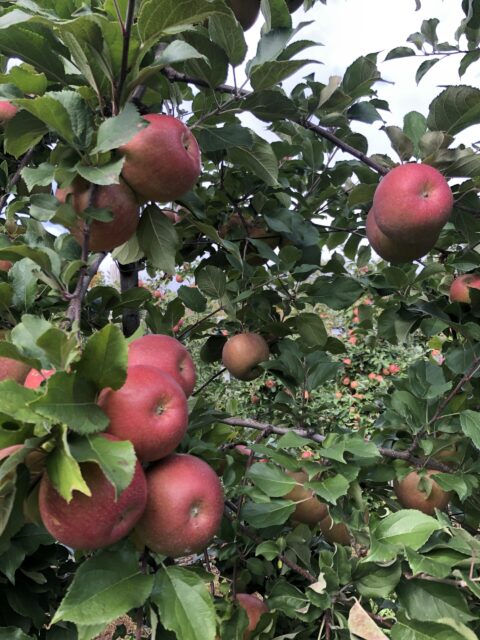“We can also tell stories of love. Those of us with power must fight for justice, for a new system that values survival over profit and flourishing transformational change over the status quo. This is radical hope: knowing that the future can be better and knowing that we are the ones who must make that future happen.”
– Eric Holthaus in The Future Earth: A Radical Vision for What’s Possible in the Age of Warming

Nine years ago, I wrote about Tiffany Glanville’s efforts to map the locations of fruit and nut trees in the West End. She recognized that already there were a number of food-bearing trees in Hartford, and wanted to encourage more planting. Once you know what you’re looking for, and then move at a speed that lets you see it, you will notice that there are food trees everywhere.

More recently, under the leadership of Carey Shea and Susan Jaafar, the Friends of Zion Hill Cemetery have enhanced the existing beauty of the park through seasonal plantings. As I write this, the last of this year’s harvest is still hanging on as the days grow colder — basil, tomatoes, and squash plants are among what can be found by the gateway on Allen Place. Blueberry bushes were added along Zion Street this past spring, with more joining them last week. New apple trees line some of the cemetery roads. Pollinator plants grow by the Ward Street and Allen Place entrances. The cemetery has been described as an asset to neighboring Trinity College.

A friend tells me he is planning to plant a few trees (native to Connecticut) somewhere in Hartford where they would be likely to thrive. Rogue gardening freaks out some folks who take pleasure in listing off all the reasons why it either won’t work or would do harm, but he has considered these aspects, talked them out with others who have more expertise than him, and is prepared to do the maintenance. That last part is key, but he has proven himself as someone who follows through.

There is no point in obsessively focusing on the cases when people who have wanted to make positive changes have been stalled by barriers; we have just as many, if not more, stories about those who do anyway.

We can be deceived into believing that everything is broken because stories of success rarely make it above the fold on newspapers/sites, and people tend to share negative content more often — to the frustration of those who are attempting to highlight humanity functioning and inspiring.

At the annual Harvest Market — the Sunday before Thanksgiving — there’s an award and recognition ceremony that requires no formal dress. Those convinced that the world is terrible would do well to put on warm clothes (it’s held in a tent) and keep their bad outlook to themselves for the occasion, but definitely attend and listen. These aren’t the kind of awards that are handed out to the most polished, best connected, or biggest fundraisers.

The HUGS Awards are given to those whose clean up and gardening efforts in the city have been appreciated. This includes, but is not limited to those who received Love Your Block Hartford resident and community grants. It’s a chance to listen to regular people across Hartford talk about their projects. You could read about these online, though it’s not the same as hearing from the doers about what sparked their efforts. I don’t think it’s possible to sit in a tent for half an hour listening to person-after-person talk about how they, with others in the community, reshaped a small corner of the world, and then leave feeling like everything is on the brink of collapse. Crime reporters who seek out the one person on a street willing to call Hartford a “war zone” should be forced to listen while dozens of residents who aren’t afraid to walk outside describe the ways in which they’re taking efforts to make this a place that flourishes.

Fair warning: if you attend, you won’t be able to make the claim that nobody cares, nobody is doing anything, and nothing is getting better in Hartford.
The photos in this most were taken in Southington, Connecticut.
Climate Possibilities is a series about climate mitigation, along with resilience, resistance, and restoration. It’s about human habitat preservation. It’s about loving nature and planet Earth, and demanding the kind of change that gives future generations the opportunity for vibrant lives. Doomers will be eaten alive, figuratively. All photographs are taken in Hartford, Connecticut unless stated otherwise.
Doing
“We can also tell stories of love. Those of us with power must fight for justice, for a new system that values survival over profit and flourishing transformational change over the status quo. This is radical hope: knowing that the future can be better and knowing that we are the ones who must make that future happen.”
– Eric Holthaus in The Future Earth: A Radical Vision for What’s Possible in the Age of Warming
Nine years ago, I wrote about Tiffany Glanville’s efforts to map the locations of fruit and nut trees in the West End. She recognized that already there were a number of food-bearing trees in Hartford, and wanted to encourage more planting. Once you know what you’re looking for, and then move at a speed that lets you see it, you will notice that there are food trees everywhere.
More recently, under the leadership of Carey Shea and Susan Jaafar, the Friends of Zion Hill Cemetery have enhanced the existing beauty of the park through seasonal plantings. As I write this, the last of this year’s harvest is still hanging on as the days grow colder — basil, tomatoes, and squash plants are among what can be found by the gateway on Allen Place. Blueberry bushes were added along Zion Street this past spring, with more joining them last week. New apple trees line some of the cemetery roads. Pollinator plants grow by the Ward Street and Allen Place entrances. The cemetery has been described as an asset to neighboring Trinity College.
A friend tells me he is planning to plant a few trees (native to Connecticut) somewhere in Hartford where they would be likely to thrive. Rogue gardening freaks out some folks who take pleasure in listing off all the reasons why it either won’t work or would do harm, but he has considered these aspects, talked them out with others who have more expertise than him, and is prepared to do the maintenance. That last part is key, but he has proven himself as someone who follows through.
There is no point in obsessively focusing on the cases when people who have wanted to make positive changes have been stalled by barriers; we have just as many, if not more, stories about those who do anyway.
We can be deceived into believing that everything is broken because stories of success rarely make it above the fold on newspapers/sites, and people tend to share negative content more often — to the frustration of those who are attempting to highlight humanity functioning and inspiring.
At the annual Harvest Market — the Sunday before Thanksgiving — there’s an award and recognition ceremony that requires no formal dress. Those convinced that the world is terrible would do well to put on warm clothes (it’s held in a tent) and keep their bad outlook to themselves for the occasion, but definitely attend and listen. These aren’t the kind of awards that are handed out to the most polished, best connected, or biggest fundraisers.
The HUGS Awards are given to those whose clean up and gardening efforts in the city have been appreciated. This includes, but is not limited to those who received Love Your Block Hartford resident and community grants. It’s a chance to listen to regular people across Hartford talk about their projects. You could read about these online, though it’s not the same as hearing from the doers about what sparked their efforts. I don’t think it’s possible to sit in a tent for half an hour listening to person-after-person talk about how they, with others in the community, reshaped a small corner of the world, and then leave feeling like everything is on the brink of collapse. Crime reporters who seek out the one person on a street willing to call Hartford a “war zone” should be forced to listen while dozens of residents who aren’t afraid to walk outside describe the ways in which they’re taking efforts to make this a place that flourishes.
Fair warning: if you attend, you won’t be able to make the claim that nobody cares, nobody is doing anything, and nothing is getting better in Hartford.
The photos in this most were taken in Southington, Connecticut.
Climate Possibilities is a series about climate mitigation, along with resilience, resistance, and restoration. It’s about human habitat preservation. It’s about loving nature and planet Earth, and demanding the kind of change that gives future generations the opportunity for vibrant lives. Doomers will be eaten alive, figuratively. All photographs are taken in Hartford, Connecticut unless stated otherwise.
Related Posts
Place this Place
Pride and Joy
Look: South Meadows